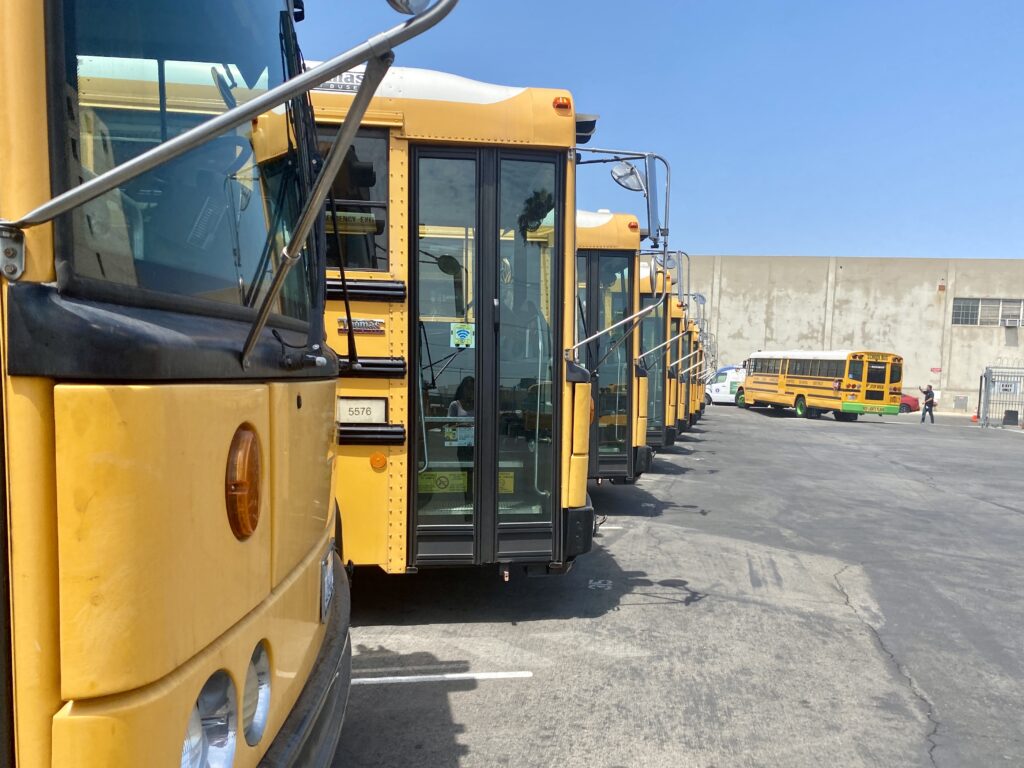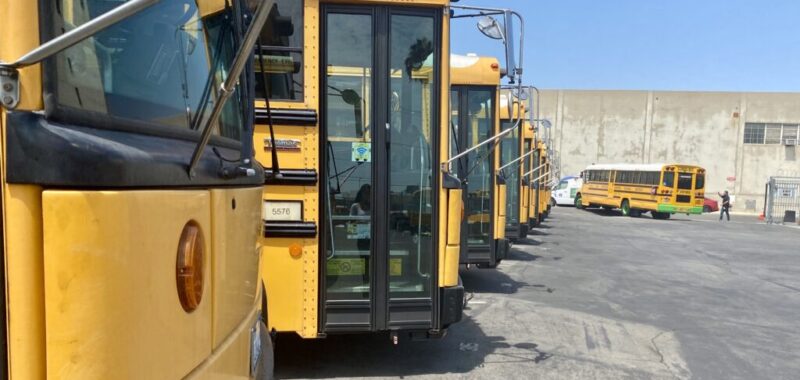
Coming up with solutions to the transportation problems of homeless students would go a long way toward reducing chronic absenteeism, advocates say.
Credit: KATE SEQUEIRA/EDSOURCE
A quiet place to complete homework, free and stable transportation options, and not immediately being penalized for missed work are among the things that Te’yana Brown said could have helped her as she faced homelessness at different points between elementary and high school.
Instead, Brown spent most mornings trying to figure out how to get to her high school. Sometimes, a family member could drive her the 45 minutes to an hour to school, while on other days she took the bus. She missed so much school at one point that she was deemed chronically absent, meaning she’d missed at least 10% of the school year.
“I think they knew periodically because I would always have absences or I would always be tardy, but I don’t think they were really concerned because, either way, I usually got my work done,” Brown responded in a recent interview to a question about whether her school knew she was experiencing homelessness. “I guess they didn’t really want to make me feel bad about it, but I wish they would have provided a little bit more resources.”

Brown was far from the only one finding it difficult to get to school as a student experiencing homelessness: Of the more than 246,000 homeless students in California during the 2022-23 school year, 40% were chronically absent, according to data analysis by SchoolHouse Connection and Poverty Solutions at the University of Michigan.
To prevent experiences like Brown’s is the reason for a new partnership between Attendance Works, a nonprofit aimed at boosting school attendance, and SchoolHouse Connection, a national homeless advocacy organization, to address how schools can increase attendance among students experiencing homelessness.
A federal law, the McKinney-Vento Homeless Assistance Act, was implemented decades ago to ensure homeless students are identified and supported. If a homeless student falls through the cracks, they miss out on services that could help them stay in school, even if their housing situation remains tenuous.
The two organizations spent months analyzing data and interviewing districts nationwide to understand how to bring homeless students back to school.
“There’s a way in which all of McKinney-Vento is about attendance. The entire effort is about increasing attendance, as well as supporting success,” said Barbara Duffield, executive director of SchoolHouse Connection.
Among the top strategies they gathered are training school staff to identify whether a student might be homeless, working together across school departments to avoid penalizing students for challenges arising from homelessness, and focusing on transportation access.
Some specific examples of districts taking homeless students’ needs into account include a county in Virginia that coordinated bus routes to motels where homeless students were living. Students admitted to being embarrassed when their classmates would see where they lived, so the bus schedule was changed to make the motels the first stop each morning and the last stop after school.
In Fresno, a team of school officials at Coalinga-Huron Unified School District meets weekly to review academics, attendance and other factors related to homeless students’ education and then take steps to support those students through that week.
While identification of homelessness is required under the federal McKinney-Vento Homeless Assistance Act, the people doing this work at schools are often understaffed and underfunded. Usually, they have to gather funding from sources unrelated to McKinney-Vento to comply with the law.
The McKinney-Vento Homeless Assistance Act’s Education for Homeless Children and Youth grant is a steady stream of funding targeted at this student population, but at $129 million nationwide, it does not reach all schools that enroll students experiencing homelessness. During the 2022-23 school year, for example, California received $14.6 million to support the educational needs of homeless students, but it reached only 127 of the state’s more than 2,000 districts. The year prior, California received $13.2 million in competitive grants that went to 136 districts.
A significant amount of federal pandemic recovery funds set aside for homeless students was also available starting in March 2021 — over $98 million that went to 92% of California’s school districts, though that was one-time funding.
A federal Department of Education study published this year found that local educational agencies that received those pandemic recovery funds saw a decrease of 5 percentage points in homeless students’ chronic absenteeism rate.
The study attributed this national trend to schools’ access to increased funding. Duffield pointed out that these decreases occurred even as student homelessness rose over the same period.
Brown was eventually able to get to school consistently and is now in her second year at Pitzer College, a private institution that is part of the Claremont Colleges in Southern California, studying management engineering on a full-ride scholarship.
Her path there, however, required transferring to a high school that offered her flexibility in managing her schoolwork and provided resources that helped her focus on school even as she looked for stable housing.
Brown’s story is not uncommon

Brown was never identified as homeless in high school despite showing signs that her basic needs were not being met, including being chronically absent and missing school assignments despite generally maintaining good grades.
She struggled academically in the first two years of high school, a time in which she and her family were doubling up with other families, eventually moving between motels. She said she didn’t receive resources outside of what all other students were offered, such as referring families to social services programs like CalWorks.
But her educational experience and her college aspirations changed when she transferred to a school that offered her more flexibility and support. Brown had started working part time at a Goodwill store at age 15, but she stayed on top of her academics because her new school was a hybrid program that required in-person classes only twice a week.
“Not all students have the flexibility to go to school eight hours a day,” Brown said. ”That can be really challenging when it comes to students from underserved communities.”
At her new school in the Pasadena area of Los Angeles, Brown had 24-hour access to tutoring platforms, regular check-ins with her teachers and academic counselor, and a college preparatory program that included university tours.
“I had a lot of other tasks that I needed to do, whether it be research for my family or working to actually support myself,” she said.
The research that Brown referred to was the time she spent searching for affordable housing for herself, her mother, and her sister.
Once Brown got into college and moved to on-campus housing, she turned to figuring out how her mother and sister could remain stable.
“It was really stressful because I had a lot of worry about how my family was going to survive. It really hurt my heart if I was able to go to college and have a roof over my head but they didn’t have a place of their own,” said Brown.
Brown’s sense of responsibility has permeated her academic life, her college application process, and her decisions now as a college student. For example, when she got an Amazon scholarship that included a housing stipend and a monthly salary, she saved most of her pay for a down payment on a home for her family.
Advocates say efforts to increase attendance will continue to fail if homeless students are not the central focus. Just last week, Fresno Unified’s school board voted to provide rental subsidies to 10 unhoused families with kids who were were chronically absent. This is the type of strategy that the partnership between Attendance Works and SchoolHouse Connection aims to highlight and help expand.
“If we’re devising strategies but we’re not paying attention to the specific circumstances of the youth who have the highest chronic absence rates and some really unique barriers,” Duffield said, “then those overall attendance efforts aren’t going to be successful.”

